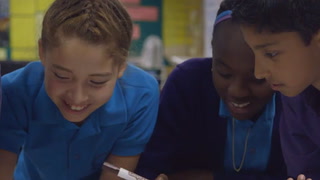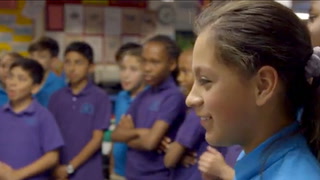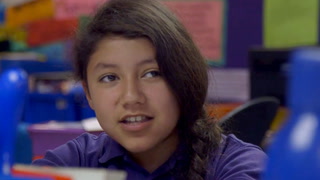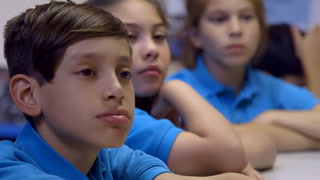Studying Balance in Art and Science Transcript
ANTOINETTE PIPPEN [sync]
00:00:02 So, let’s just take a minute to look at this basin.
ANTOINETTE PIPPEN
00:00:09 Today in class, I engaged my students in a discussion centered on the analysis of an oval basin. Art really gets them thinking. It gets them questioning. And when they’re creating art, then they’re having to synthesize the facts.
00:00:26 And through that exploration we can delve deeper and deeper into the science standards and what is a sustainable, balanced ecosystem.
00:00:35 [TITLE: Arts Integration: Studying Balance in Art and Science]
ANTOINETTE PIPPEN [sync]
00:00:37 What do you see here?
PONYTAIL
It’s a plate that someone decorated. I think that they were thinking of animals.
ANTOINETTE PIPPEN
00:00:47 The learning objective is that students make claims about the health of an ecosystem based on an observation of an art piece, an oval basin created in the 16th century by Bernard Palissy.
00:01:02 It’s actually life casted, so the objects on it were made from molds of actual animals. So, that’s always intriguing to the students. Just by collecting in one place, you can actually recreate a habitat. We use that to be able to discuss sustainability and balance within an ecosystem.
00:01:20 And balance artistically, if we’re looking at the placement of the different specimens.
ANTOINETTE PIPPEN [sync]
00:01:25 Can anyone give me a definition of the world balance? Daniel?
DANIEL
00:01:32 The same on two sides.
BOY IN BLUE WITH BANGS
00:01:35 Like, [unintell], they, like, don’t eat too much of something or not too little of something.
PONYTAIL
Also, you can do your homework and you can do your classwork, but you need to do both at the same- same-
ANTOINETTE PIPPEN
00:01:54 Balance is a difficult concept for the students. And it’s also subjective, artistically. But in talking about ecosystems, you talk about that delicate balance that we are part of.
00:02:07 [TITLE: NGSS Science Standard]
[TITLE: Organisms are in food webs.]
ANTOINETTE PIPPEN [sync]
00:02:09 Just start with what do you think…
ANTOINETTE PIPPEN
00:02:10 And in that NGSS standard, the life science standard that talks about ecosystems, it mentions web of life, how we as humans are part of that web of life. If you can discuss the concept of balance in as many different ways as possible, they can really start understanding that word in different ways.
ANTOINETTE PIPPEN [sync]
00:02:30 The artist would actually go and collet these live specimens and he made molds from the actual bodies of the animals.
STUDENT
That’s cool.
ANTOINETTE PIPPEN [sync]
It is kind of cool.
ANTOINETTE PIPPEN
00:02:40 There are so many opportunities to use art in whatever you’re teaching. And there’s so much available to you online. I was able to download high-resolution images through the Getty website.
00:02:54 [TITLE: Search Lesson & Activities on www.Getty.edu/Education/Teachers]
ANTOINETTE PIPPEN
00:02:55 There is an extensive database of different works of art just at your fingertips.
ANTOINETTE PIPPEN [sync]
00:03:00 So, look at these through the eyes of an ecosystem. And we might identify what are the producers- What’s after producer?
STUDENTS
Consumer.
ANTOINETTE PIPPEN [sync]
00:03:11 Primary consumer.
STUDENTS
Secondary consumer. Tertiary consumer.
ANTOINETTE PIPPEN [sync]
We also have the Decomposers.
ANTOINETTE PIPPEN
00:03:21 In class we’ve done different informative readings on biodiversity, and elements of an ecosystem. All of those have helped them develop the background about how there’s this web of factors that all depend on one another.
ANTOINETTE PIPPEN [sync]
00:03:38 If all these creatures come from the same habitat, what is the habitat?
GIRL IN PURPLE
The habitat would be near the water?
ANTOINETTE PIPPEN [sync]
00:03:45 Do we think it’s fresh water or do we think it’s salt water?
GIRL WITH EARRINGS
00:03:49 The animal that tells us this- that this would be a fresh water habitat is the frog. Because I know that frogs don’t really live near salt water.
00:04:01 [TITLE: Common Core Standard]
[TITLE: Present an opinion using relevant facts and details]
ANTOINETTE PIPPEN [sync]
00:04:02 So, they tend to be a fresh water animal.
ANTOINETTE PIPPEN
00:04:06 Based on some of the animals and organisms that they saw, we classify them. The important part was that they are trying to analyze the interactions of the species. And some of them they didn’t recognize. And that’s okay.
00:04:19 It’s more about understanding how the species interact, rather than exactly which species they are.
ANTOINETTE PIPPEN [sync]
00:04:26 Does anyone know what else lizards might eat?
STUDENT
Lizards might eat a snail.
ANTOINETTE PIPPEN [sync]
00:04:31 So, that would make it a secondary consumer.
JOSUE
I think a snail can be a Decomposer.
00:04:36 [TITLE: Common Core Standard]
[TITLE: Respond to questions that contribute to the topic under discussion]
ANTOINETTE PIPPEN [sync]
00:04:37 You think it would eat dead matter?
ANTOINETTE PIPPEN
00:04:40 After we classify the different flora and fauna on the basin, I ask the students, “Is this a balanced ecosystem?” Or also, artistically, “Is this balanced as a piece of art?” They’ve already had instruction on the elements of art. They are very fluent in many of the different words we use to describe art - the shadow, the line, the color.
00:05:03 The students point out the exact details that are evidence for their claim.
ANTOINETTE PIPPEN [sync]
00:05:09 Looking at this as a piece of art, would you say that it is balanced or imbalanced?
PONYTAIL
00:05:16 It doesn’t look balanced. The snake in the middle doesn’t match.
ANTOINETTE PIPPEN [sync]
So, you’re saying this snake in the middle makes it imbalanced?
PONYTAIL
Yes.
ANTOINETTE PIPPEN [sync]
00:05:26 Does anyone disagree?
BRAID
I think this piece of art is balanced. The crayfish are both on different sides. And the leaves are spreaded out everywhere.
00:05:40 [TITLE: Common Core Standard]
[TITLE: Engage in collaborative discussions, building on others’ ideas & expressing opinions]
ANTOINETTE PIPPEN [sync]
00:05:40 So, we hear different perspectives, different points of view about…
ANTOINETTE PIPPEN
00:05:44 By having them respond to each other, not only does it encourage them to talk more, but they are hearing all these different points of view and by the end, they grow in the depth of their understanding.
ANTOINETTE PIPPEN [sync]
00:05:56 How many people think this is a balanced ecosystem? If you think it’s balanced, give me a thumbs up. If you think it’s imbalanced, thumbs down.
00:06:08 So, most of you think it’s imbalanced.
ANTOINETTE PIPPEN
00:06:11 Artistically, I think it was much more subjective. Some people thought it was balanced, some people thought it was unbalanced. But scientifically when we looked at it, it was pretty clear that it was an imbalanced ecosystem, based on their analysis. Because there were many more secondary consumers.
00:06:28 So, after having that group discussion I asked them, I was like, “Now, make a new oval basin, but use the species from the kelp forest.”
ANTOINETTE PIPPEN [sync]
00:06:36 You need to show a balanced habitat using the organisms that you know about from the kelp forest.
PURPLE SCRUNCHIE
We can draw, like, animals in the ecosystem of the kelp forest?
ANTOINETTE PIPPEN [sync]
00:06:48 Mm-hmm [affirmative].
PURPLE SCRUNCHIE
Okay.
ANTOINETTE PIPPEN
00:06:50 They went on a class trip to Catalina where they had firsthand interaction with kelp forest.
00:06:57 [TITLE: NGSS Science Standard]
[TITLE: Develop a model to show movement of matter among plants, animals & environment]
ANTOINETTE PIPPEN
00:07:05 In order to create this art, they had to look at the diagrams. They had to use their resources. And really think, “What is this diagram depicting?” After they sketched out their basins, we then put them all up on the white board and just had a simple gallery walk.
00:07:24 And students commented on each other’s work or their own work. By having an audience, there’s definitely more of a sense of importance.
ANTOINETTE PIPPEN [sync]
00:07:32 Do you think that’s a balanced ecosystem?
GIRL IN BLUE WITH BRAID
No. There’s not enough biodiversity for it to be a healthy ecosystem because I don’t see anything the sea star could eat.
ANTOINETTE PIPPEN
00:07:46 So, after this, they revisit their basin – is it balanced? – to make sure that this is a sustainable, balanced ecosystem.
ANTOINETTE PIPPEN [sync]
00:07:55 Does everyone think that there’s something more that they need to add to their basin?
STUDENT
Yes.
ANTOINETTE PIPPEN [sync]
00:08:01 So, tomorrow, make sure all your species have food to eat, and competition.
ANTOINETTE PIPPEN
00:08:08 I think that the students are getting a lot more science and scientific thinking through studying art. The language and analysis that they get from looking at art frees them to think about things from different perspectives. And it allows them to understand that there’s no right or wrong answer necessarily.
00:08:27 But there’s better justified answers, there’s more evidence for particular answers. And that’s really the same in art and science.
00:08:40 ***FILE END***













3 Comments
Lucretia Tripp Mar 24, 2020 3:44pm
My preservice teachers really enjoyed this video about balancing art. It was a great activity to show them how to integrate science with art. They are excited one day to use in thier classes when schools reopen,
Cheryle Peters Jan 7, 2017 5:06am
teresa pulido Nov 5, 2015 4:55pm